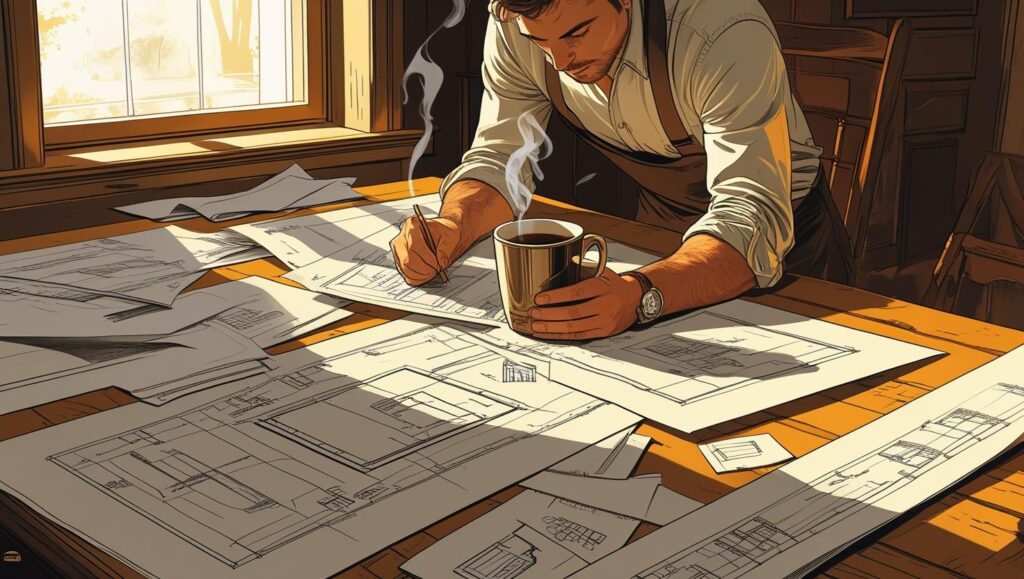This post contains affiliate links. If you purchase through these links, I may earn a small commission at no extra cost to you.

Why Planning Felt Impossible for Me
Let me guess – you’ve been there too?
Standing in Target, staring at the gorgeous planners with their pristine pages and perfect layouts, thinking “This is it! This planner will change my life!”
Fast forward two weeks: said planner is buried under a pile of laundry, forgotten and abandoned like all the others before it.
I get it. I’ve been there more times than I care to count.
Forever, I thought I was just “bad at planning.” I’d either create these elaborate, color-coded systems with my gel pens that looked amazing for exactly three days, or I’d forget about planning entirely until Sunday night panic set in.
Sound familiar?
Here’s what I’ve learned: our ADHD brains don’t need perfect planning systems – we need simple, flexible ones that work WITH our neurodivergent wiring, not against it.
I’m not a productivity expert or professional organizer. I’m just a fellow ADHD mom sharing what’s finally working for me.
My Mindset Shift About Planning With ADHD
Before I share my routine, let’s talk about the game-changing mindset shift that made all the difference.
I used to think that if I didn’t follow my plan exactly, I was a failure. News flash: that perfectionist thinking was sabotaging me before I even started. All or Nothing thinking is doing NOTHING for us.
Now I know that planning tips for ADHD women need to include flexibility as a core feature, not a bug.
Here’s my new planning philosophy:
- Plans are meant to be adjusted
- “Good enough” is actually good enough
- Simple systems beat fancy ones every single time
- Flexibility prevents the all-or-nothing spiral

My Simple Weekly Planning Routine (Step-by-Step)
Okay, here’s the ADHD weekly planner routine that’s been working for me the last few weeks (which is basically a record for me, honestly).
Step 1: Choose One Planning Tool & Stick With It
The key word here is ONE.
I know, I know. That digital calendar is calling your name while your bullet journal sits there looking all aesthetic. But trust me on this – pick one and commit. I use Trello only for project flows and plan accordingly with a planning pad.
My current setup: A simple weekly planner pad that sits open on my kitchen counter. It’s always visible, which is crucial for my ADHD brain that operates on “out of sight, out of mind.”
Why this works for my ADHD brain:
- Visual reminders keep planning top-of-mind
- No decision fatigue about which tool to use
- One central location prevents scattered information
Step 2: Pick a Weekly Planning Day (And Protect It)
Saturday mornings work for me, but find what works for YOUR schedule.
Maybe it’s Monday morning with your coffee/tea, or Friday afternoon as you wrap up the week. The timing matters less than the consistency.
Pro tip: Set a recurring reminder on your phone. Even after weeks of doing this, I still need that gentle nudge.
Step 3: Start With the Big Rocks
This is where most ADHD-friendly routines begin – with the non-negotiables.
I start by writing down:
- Work commitments
- Appointments
- Kids’ activities
- Any social plans
Why this prevents ADHD overwhelm: When you see your fixed commitments first, you get a realistic picture of your available time. No more accidentally scheduling three major tasks on the day you have back-to-back meetings.
Step 4: Add “Must-Do” Tasks, Then Sprinkle in Extras
Here’s my rule: Maximum 3 must-do tasks per day. That’s it.
Everything else goes in the “if I have time and energy” category.
Example from my planner:
- Monday Must-Do’s: Grocery run, finish blog post, prep Tuesday’s dinner
- Monday Extras: Organize linen closet, call mom, research vacation spots
This ADHD planning system works because: It prevents overcommitment while still capturing those “wouldn’t it be nice if…” tasks.
Step 5: Break Down Larger Tasks Into Small, Actionable Steps
Vague tasks are ADHD kryptonite. For me they are at least.
Instead of writing “work on blog,” I write:
- “Write intro for weekly planning post”
- “Find 2 photos for post”
- “Schedule social media posts”
Why this helps ADHD brains: Clear, specific actions eliminate the mental energy spent figuring out where to start.
Step 6: Build in Buffer Time
This was my biggest game-changer.
I used to schedule things back-to-back like I was some kind of productivity robot. Spoiler alert: I’m not.
Now I build in 15-30 minute buffers between activities. Sometimes I implement the pomodoro technique doing tasks in 25 minute intervals with five minutes in between. This gives my brain time to transition and prevents that rushed, overwhelmed feeling.
Step 7: Review & Adjust Midweek
Wednesday check-ins are my secret weapon.
I spend 5 minutes looking at the rest of my week and asking:
- What’s not realistic anymore?
- What can I move to next week?
- What do I need to add?
This prevents the Friday panic when you realize you’ve accomplished nothing you planned and feel like a complete failure.
You can find more routines I work into my busy life in this post, 5 Simple Reset Routines

ADHD-Friendly Planning Tips I Use to Make It Stick
Here are the little tweaks that transformed my planning from pretty but useless to actually functional:
Keep it visible: My planner lives open on the kitchen counter, not hidden in a drawer
Color-code strategically: Different color ink for work, family, and personal tasks (but don’t go overboard – 3 colors max)
Use sticky notes for flexible stuff: Anything that might move gets written on a sticky note first
Build in rewards: Finished my weekly planning? That deserves a chai tea or 20 minutes of mindless scrolling
Embrace “good enough”: Some weeks my planning is thorough, other weeks it’s bare bones. Both are perfectly fine.
Encouragement for Fellow ADHD Planners
Listen, your ADHD time management tips and systems don’t have to look like the perfectly curated Instagram posts.
Your planning routine doesn’t need to be Pinterest-worthy to be effective.
What matters is finding something that works for YOUR brain, YOUR life, and YOUR energy levels.
Some weeks you’ll nail your planning routine. Other weeks you’ll wing it entirely. Both are okay. Both are part of living with a neurodivergent mind.
The goal isn’t perfection – it’s progress.
Start small. Maybe this week you just pick your planning tool. Next week you add the weekly planning session. Small, consistent steps will get you there.
You’ve got this, mama. One week at a time.
What planning struggles do you face with your ADHD brain? I’d love to hear what’s working (or not working) for you in the comments below!
The information shared in this post is based on my personal experience living with ADHD and is not intended as professional medical or therapeutic advice. Every ADHD brain is different, and what works for me may not work for everyone. If you’re struggling with ADHD symptoms that significantly impact your daily life, please consult with a qualified healthcare professional or ADHD specialist for personalized guidance and support.